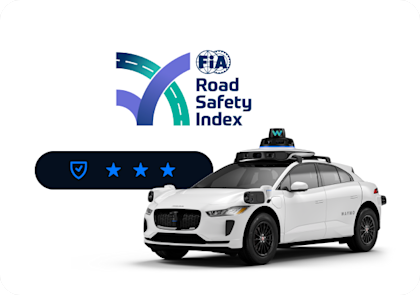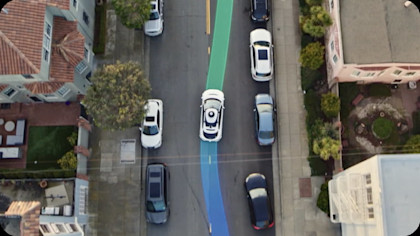Seguridad
Explora nuestro Marco de casos de seguridad
Nuestra filosofía de seguridad
Hasta la fecha, los datos indican que Waymo Driver reduce las lesiones y las muertes relacionadas con accidentes de tráfico en los lugares donde actualmente ofrecemos servicios. En Waymo, nuestro objetivo es reducir las lesiones y muertes por tráfico conduciendo de manera segura y responsable, y gestionaremos cuidadosamente los riesgos a medida que escalemos nuestras operaciones.
Porque la seguridad es urgente
En Waymo, creemos que el statu quo de la seguridad vial es inaceptable. La tecnología de conducción autónoma puede salvar vidas y mejora la movilidad para todos.

-
1.19 Mde muertes anuales en todo el mundo debido a accidentes de tránsito
-
42,514muertes en EE.UU. en 2022 y 2.5 millones de lesiones
-
USD 836,000 Men daños por pérdida de vidas y lesiones cada año
-
50 Mde lesiones anuales en todo el mundo debido a accidentes de tránsito
Carreteras más seguras para todos, hoy
En nuestros primeros 53 millones de kilómetros:
Overall crash reduction
88% Menos accidentes con lesiones graves o peores (15 menos)
79% Menos accidentes en los que se activaron los airbags (94 menos)
78% Menos colisiones que causan lesiones (223 menos)
Crash reductions involving injuries to Vulnerable Road Users
93% Fewer pedestrian crashes with injuries (28 fewer)
81% Fewer cyclist crashes with Injuries (17 fewer)
86% Fewer motorcycle crashes with injuries (13 fewer)
En comparación con un ser humano que conduce la misma distancia en las ciudades donde operamos.
El conductor más experimentado del mundo
-
Decenas de miles de pasajeros felices
Por semanas, atendemos a decenas de miles de pasajeros en Phoenix, San Francisco, Los Ángeles y, próximamente, Austin.
-
Más seguro que los vehículos conducidos por personas
Con un 100% menos de reclamos por lesiones corporales y un 76% menos de reclamos por daños a la propiedad, Swiss Re (una de las principales aseguradoras del mundo) concluyó que Waymo es significativamente más seguro que los vehículos conducidos por humanos.
-

Más de una década de experiencia
Comenzamos como el Proyecto de vehículos autónomos de Google en 2009 y ofrecimos el primer viaje completamente autónomo en 2015.
-

Decenas de millones de millas
Tenemos más de 40 millones de millas de experiencia de conducción en el mundo real, lo que equivale a conducir a la Luna ida y vuelta unas 80 veces.
Committed to Vision Zero
Top-Rated on the FIA Road Safety Index
Top-Rated on the FIA Road Safety Index

Waymo’s ride-hailing service received a 3-star rating (the highest possible) on the FIA Road Safety Index. The FIA Road Safety Index rates an organization’s current traffic safety performance and safety footprint. A top rating signifies that Waymo’s service follows best practices to achieve Vision Zero goals, like using the safest vehicles, requiring seat belt use, and having policies to follow the speed limit.
Starting with the safest vehicles
Starting with the safest vehicles

Waymo builds its service on some of the safest vehicle platforms, each rigorously tested and awarded top ratings in crashworthiness evaluations, including protection provided by airbags, seat belts, and crash structures.
Improving Road Safety Today
Improving Road Safety Today

Some of the most impactful safety measures are also the simplest – consistently obeying speed limits and ensuring seatbelt use. A driver like the Waymo Driver that is always alert, does not speed, requires seat belts, and uses the newest vehicles can eliminate a majority of serious injuries. Combined with Waymo’s safety research and robust safety framework, the data indicates the Waymo Driver is already reducing traffic injuries and fatalities in the places where we currently operate.
The Vision Zero Network is a collaborative campaign to help communities reach their goals of Vision Zero — eliminating all traffic fatalities and severe injuries — while increasing safe, healthy, equitable mobility for all. The U.S. Department of Transportation National Roadway Safety Strategy (NRSS) marks a critical step toward an ambitious long-term goal of reaching zero traffic fatalities on American roads. Waymo supports the NRSS by advancing Safer Vehicles and Safer Speeds through the research and deployment of its fully autonomous ride-hailing service, Waymo One.


Investigación en seguridad
Realizamos estudios activamente y publicamos los hallazgos revisados por pares sobre nuestras metodologías de seguridad, datos de rendimiento y más.

